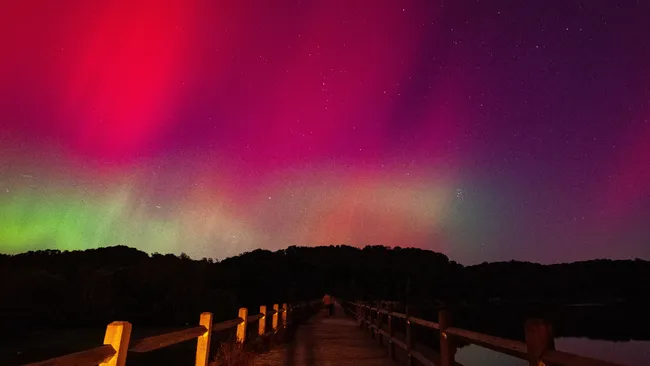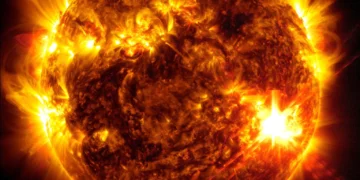On October 10, 2024, a geomagnetic storm from a coronal mass ejection (CME) lit up the skies, creating vibrant Northern Lights visible across much of North America and Europe.
The Science Behind the Geomagnetic Storm
A geomagnetic storm is triggered when energy from solar winds, often in the form of a CME, interacts with Earth’s magnetic field. On October 8, sunspot AR 3848 unleashed a CME that traveled toward Earth at a staggering speed of 2.9 million mph (4.6 million kph). Covering the 93 million miles between the Sun and Earth in just two days, this mass of charged particles collided with the planet’s magnetosphere, causing it to compress and allowing these particles to penetrate the atmosphere.
As these particles streamed into the atmosphere, they collided with atoms of oxygen and nitrogen. This collision released photons, creating the colorful light displays we see as auroras. The specific colors—green, pink, red, and purple—are determined by the type of gas the particles interact with. Oxygen tends to emit green and red light, while nitrogen produces blue and purple hues. The October 2024 event was particularly vibrant because of the sheer volume of charged particles and the intensity of the geomagnetic storm.
Global Impact and Reach of the Aurora
What made the October 2024 geomagnetic storm stand out was its visibility far beyond the usual regions. Typically, auroras are confined to areas close to the poles, but this storm’s strength brought the Northern Lights to more southerly regions. People in Indiana, New York, and even parts of southern Canada were treated to this rare spectacle. Neil deGrasse Tyson, the famed astrophysicist, shared his excitement about seeing the auroras from Long Island, New York, amplifying the public’s enthusiasm on social media.

The widespread visibility of the auroras turned this into a global event, with people from all walks of life sharing their experiences online. The skies above Bloomington, Indiana, erupted with green and pink lights, leaving onlookers mesmerized. In Europe, the lights danced over iconic locations like the Great Wall of China and Whitby Harbour in the UK, where spectators were equally captivated. This event demonstrated how a natural phenomenon could transcend geographic boundaries, uniting people across the world in shared wonder.
The Importance of Studying Space Weather
While the October auroras were a breathtaking sight, they also highlighted the importance of space weather research. Geomagnetic storms, like the one that occurred, are caused by solar flares and CMEs. These storms can have significant impacts on Earth’s technology and infrastructure. Solar activity can disrupt satellite communications, GPS systems, and even power grids. In extreme cases, geomagnetic storms have been known to cause widespread blackouts, as seen during the Carrington Event of 1859.
Although the October 2024 storm did not result in any major technological disruptions, it serves as a reminder of the potential dangers posed by space weather. Understanding how solar activity affects Earth’s magnetosphere is crucial for predicting future storms and mitigating their impacts. This event provided scientists with valuable data to further refine their space weather forecasting models, improving our ability to anticipate and prepare for similar occurrences in the future.
A Unique Opportunity for Public Engagement
The October 2024 auroras were not only a scientific marvel but also an opportunity for public engagement with science. Social media platforms were flooded with images and videos of the auroras, as both amateur photographers and professional skywatchers documented the event. Platforms like X (formerly Twitter) became hubs of activity, with users sharing their awe-inspiring photos and discussing the science behind the phenomenon.

One of the most striking examples of this public engagement came from Neil deGrasse Tyson, who shared his experience of viewing the auroras from Long Island. His tweets helped spread awareness and excitement about the event, turning a natural phenomenon into a global spectacle. By making science accessible and engaging, events like this inspire curiosity and wonder about the universe.
Lessons Learned and Future Outlook
The spectacular auroras of October 2024 offer valuable lessons for both scientists and the general public. This event is a stark reminder of the need for continued research into space weather. As we enter a period of increased solar activity, known as Solar Cycle 25, we can expect more geomagnetic storms in the coming years. Solar activity is expected to peak around 2025, meaning that more auroral displays—and potentially more disruptions to technology—are on the horizon.
The October 2024 storm also underscored the importance of being prepared for the potential impacts of space weather. While this event did not cause significant technological disruptions, it served as a wake-up call. Modern society relies heavily on satellite-based technologies, and geomagnetic storms can disrupt these systems in unpredictable ways.
Looking forward, it is essential to stay informed about space weather. As solar activity increases, so too does the likelihood of more geomagnetic storms. Monitoring solar activity and understanding the potential impacts of these storms will be crucial for protecting our technology and infrastructure.
Conclusion: A Celestial Spectacle and Scientific Opportunity
The geomagnetic storm of October 2024 was a celestial event that will be remembered for years to come. For three hours, people across the globe were treated to one of nature’s most beautiful light shows, as the Northern Lights danced across the sky in unexpected locations. But beyond the visual spectacle, this event also provided scientists with valuable data on space weather and highlighted the importance of studying the Sun’s activity.
In the end, the October 2024 auroras were more than just a beautiful display—they were a reminder of the interconnectedness of our solar system and the need to appreciate and protect the technology we rely on every day. Whether you witnessed the event firsthand or saw it through the lens of a camera, the memory of this celestial spectacle will continue to inspire awe and curiosity for years to come.



















